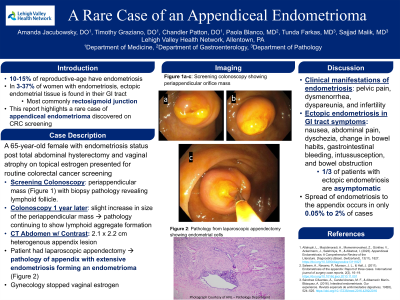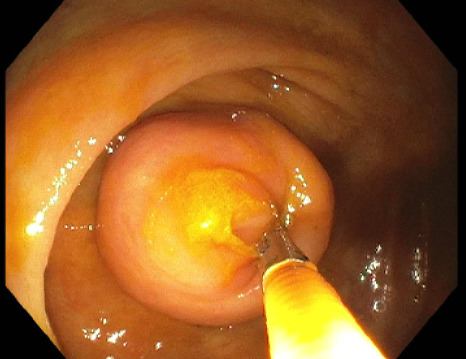Tuesday Poster Session
Category: Colon
P3689 - A Rare Case of an Appendiceal Endometrioma
Tuesday, October 29, 2024
10:30 AM - 4:00 PM ET
Location: Exhibit Hall E

Has Audio

Amanda Jacubowsky, DO
Lehigh Valley Health Network
Allentown, PA
Presenting Author(s)
Amanda Jacubowsky, DO1, Timothy Graziano, DO1, Chandler Patton, DO1, Paola Blanco, MD2
1Lehigh Valley Health Network, Allentown, PA; 2Eastern Pennsylvania Gastrointestinal and Liver Specialists, Allentown, PA
Introduction: Endometriosis is a common condition present in 10-15% of reproductive-age women. Endometrium-like epithelium can spread to alternative sites including the ovaries, fallopian tubes, and pelvic peritoneum. In 3-37% of women with endometriosis, ectopic endometrial tissue is found in their gastrointestinal tract, most commonly in the rectosigmoid junction. Here, we present a rare case of appendiceal endometrioma discovered on routine colonoscopy screening.
Case Description/Methods: A 65-year-old female with a past medical history of endometriosis status post total abdominal hysterectomy and vaginal atrophy on topical estrogen presented to her gastroenterologist for a routine screening colonoscopy. She denied weight loss, night sweats, abdominal pain, melena, or hematochezia. During the colonoscopy, she was found to have 2 hepatic flexure sessile serrated polyps, 4 ascending colon tubular adenomas, and a periappendicular mass with biopsies showing a lymphoid follicle. One year later, the patient had a repeat colonoscopy with a slight increase in the size of the periappendicular mass and pathology continuing to show lymphoid aggregate formation. She had a CT abdomen and pelvis with contrast performed for further characterization of her appendiceal mass. It revealed a 2.1 x 2.2 cm heterogenous appendix lesion. With an unclear etiology and an increase in the size of the mass, the patient was referred to colorectal surgery. She underwent a laparoscopic appendectomy and the pathology of her appendix revealed extensive endometriosis involving the subserosa and extending into the muscularis mucosa, forming an endometrioma. She was referred to gynecology who recommended against the use of vaginal estrogen to prevent stimulation of remaining endometrial cells.
Discussion: Clinical manifestations of endometriosis typically occur during a woman’s menstrual cycle and include pelvic pain, dysmenorrhea, dyspareunia, and infertility. In gastrointestinal endometriosis, ectopic endometrial tissue grows outside or inside the intestines and rectum. The spread of endometriosis to the appendix occurs in only 0.05% to 2% of cases, making it an exceedingly rare diagnosis. Additionally, it can cause nonspecific symptoms including nausea, abdominal pain, dyschezia, change in bowel habits, gastrointestinal bleeding, intussusception, and bowel obstruction. It is common to miss a diagnosis of ectopic endometriosis as one-third of patients are asymptomatic and the condition is diagnosed incidentally, as seen in our case.

Disclosures:
Amanda Jacubowsky, DO1, Timothy Graziano, DO1, Chandler Patton, DO1, Paola Blanco, MD2. P3689 - A Rare Case of an Appendiceal Endometrioma, ACG 2024 Annual Scientific Meeting Abstracts. Philadelphia, PA: American College of Gastroenterology.
1Lehigh Valley Health Network, Allentown, PA; 2Eastern Pennsylvania Gastrointestinal and Liver Specialists, Allentown, PA
Introduction: Endometriosis is a common condition present in 10-15% of reproductive-age women. Endometrium-like epithelium can spread to alternative sites including the ovaries, fallopian tubes, and pelvic peritoneum. In 3-37% of women with endometriosis, ectopic endometrial tissue is found in their gastrointestinal tract, most commonly in the rectosigmoid junction. Here, we present a rare case of appendiceal endometrioma discovered on routine colonoscopy screening.
Case Description/Methods: A 65-year-old female with a past medical history of endometriosis status post total abdominal hysterectomy and vaginal atrophy on topical estrogen presented to her gastroenterologist for a routine screening colonoscopy. She denied weight loss, night sweats, abdominal pain, melena, or hematochezia. During the colonoscopy, she was found to have 2 hepatic flexure sessile serrated polyps, 4 ascending colon tubular adenomas, and a periappendicular mass with biopsies showing a lymphoid follicle. One year later, the patient had a repeat colonoscopy with a slight increase in the size of the periappendicular mass and pathology continuing to show lymphoid aggregate formation. She had a CT abdomen and pelvis with contrast performed for further characterization of her appendiceal mass. It revealed a 2.1 x 2.2 cm heterogenous appendix lesion. With an unclear etiology and an increase in the size of the mass, the patient was referred to colorectal surgery. She underwent a laparoscopic appendectomy and the pathology of her appendix revealed extensive endometriosis involving the subserosa and extending into the muscularis mucosa, forming an endometrioma. She was referred to gynecology who recommended against the use of vaginal estrogen to prevent stimulation of remaining endometrial cells.
Discussion: Clinical manifestations of endometriosis typically occur during a woman’s menstrual cycle and include pelvic pain, dysmenorrhea, dyspareunia, and infertility. In gastrointestinal endometriosis, ectopic endometrial tissue grows outside or inside the intestines and rectum. The spread of endometriosis to the appendix occurs in only 0.05% to 2% of cases, making it an exceedingly rare diagnosis. Additionally, it can cause nonspecific symptoms including nausea, abdominal pain, dyschezia, change in bowel habits, gastrointestinal bleeding, intussusception, and bowel obstruction. It is common to miss a diagnosis of ectopic endometriosis as one-third of patients are asymptomatic and the condition is diagnosed incidentally, as seen in our case.

Figure: Colonoscopy with concern for mass at the appendiceal orifice
Disclosures:
Amanda Jacubowsky indicated no relevant financial relationships.
Timothy Graziano indicated no relevant financial relationships.
Chandler Patton indicated no relevant financial relationships.
Paola Blanco indicated no relevant financial relationships.
Amanda Jacubowsky, DO1, Timothy Graziano, DO1, Chandler Patton, DO1, Paola Blanco, MD2. P3689 - A Rare Case of an Appendiceal Endometrioma, ACG 2024 Annual Scientific Meeting Abstracts. Philadelphia, PA: American College of Gastroenterology.
